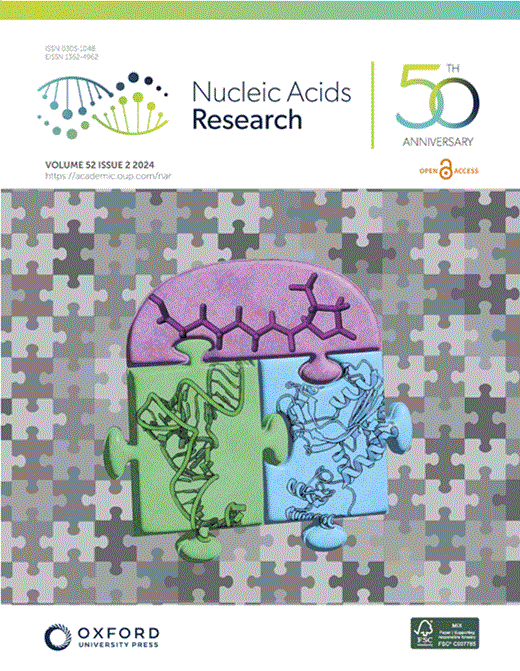Comparative mitochondrial genome and transcriptome analyses reveal strain-specific features of RNA editing in Trypanosoma brucei
IF 16.6
2区 生物学
Q1 BIOCHEMISTRY & MOLECULAR BIOLOGY
引用次数: 0
Abstract
Trypanosoma brucei, a kinetoplastid parasite, cycles between a tsetse fly vector and a mammalian host, undergoing profound changes in cell architecture and metabolism. Central to these transitions are modifications in mitochondrial structure, volume, and energy production. The parasite’s mitochondrial genome is highly complex, comprising a few maxicircles that encode proteins and rRNAs, and thousands of minicircles that encode guide RNAs (gRNAs). Most messenger RNAs (mRNAs) sustain gRNA-directed U-insertion/deletion editing to acquire functional protein-coding sequences. Although the minicircle repertoire varies among isolates and environmental conditions, the extent and biological significance of this variability in commonly used laboratory strains remain unclear. Here, we analyzed mitochondrial genomes and transcriptomes of the developmentally competent AnTat1.1 strain, the differentiation-incapable Lister 427 strain, and transgenic derivatives of Lister 427. While maxicircle sequences are broadly conserved and stable, minicircles differ markedly in sequence complexity, relative abundance, and gRNA gene content. These variations likely affect the efficiency and accuracy of mRNA editing. Compared with Lister 427, the AnTat1.1 strain retains greater minicircle diversity, longer predicted gRNA–mRNA duplexes, and higher editing fidelity. By examining cell lines with distinct developmental capacities and cultivation histories, our findings reveal how mitochondrial genomes evolve in response to changing environmental contexts.比较线粒体基因组和转录组分析揭示了布鲁氏锥虫RNA编辑的菌株特异性特征
布鲁氏锥虫是一种动质体寄生虫,在采采蝇载体和哺乳动物宿主之间循环,细胞结构和代谢发生深刻变化。这些转变的核心是线粒体结构、体积和能量产生的改变。寄生虫的线粒体基因组非常复杂,包括编码蛋白质和rrna的几个大环,以及编码引导rna (gRNAs)的数千个小环。大多数信使rna (mrna)维持grna导向的u插入/删除编辑以获得功能性蛋白质编码序列。尽管在不同的分离株和不同的环境条件下,这种变异的程度和生物学意义在常用的实验室菌株中仍不清楚。在这里,我们分析了发育正常的AnTat1.1菌株、分化能力低下的Lister 427菌株和Lister 427转基因衍生物的线粒体基因组和转录组。大环序列具有广泛的保守性和稳定性,而小环序列在序列复杂性、相对丰度和gRNA基因含量方面存在显著差异。这些变异可能影响mRNA编辑的效率和准确性。与Lister 427相比,AnTat1.1菌株保留了更大的微环多样性,更长的预测gRNA-mRNA双链,更高的编辑保真度。通过研究具有不同发育能力和培养历史的细胞系,我们的发现揭示了线粒体基因组如何随着环境的变化而进化。
本文章由计算机程序翻译,如有差异,请以英文原文为准。
求助全文
约1分钟内获得全文
求助全文
来源期刊

Nucleic Acids Research
生物-生化与分子生物学
CiteScore
27.10
自引率
4.70%
发文量
1057
审稿时长
2 months
期刊介绍:
Nucleic Acids Research (NAR) is a scientific journal that publishes research on various aspects of nucleic acids and proteins involved in nucleic acid metabolism and interactions. It covers areas such as chemistry and synthetic biology, computational biology, gene regulation, chromatin and epigenetics, genome integrity, repair and replication, genomics, molecular biology, nucleic acid enzymes, RNA, and structural biology. The journal also includes a Survey and Summary section for brief reviews. Additionally, each year, the first issue is dedicated to biological databases, and an issue in July focuses on web-based software resources for the biological community. Nucleic Acids Research is indexed by several services including Abstracts on Hygiene and Communicable Diseases, Animal Breeding Abstracts, Agricultural Engineering Abstracts, Agbiotech News and Information, BIOSIS Previews, CAB Abstracts, and EMBASE.
 求助内容:
求助内容: 应助结果提醒方式:
应助结果提醒方式:


